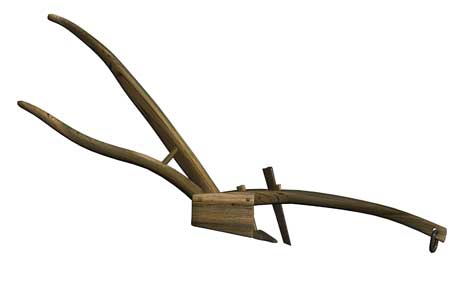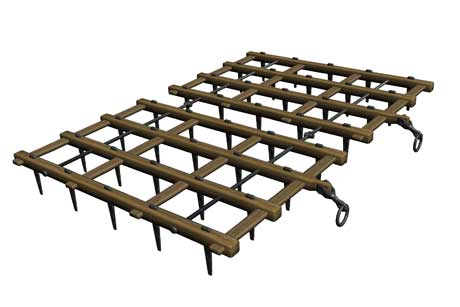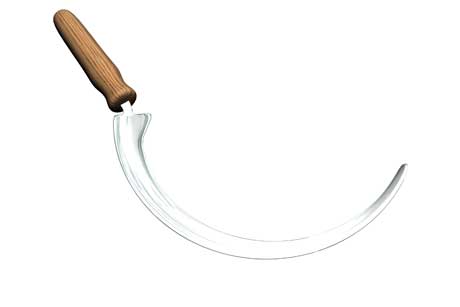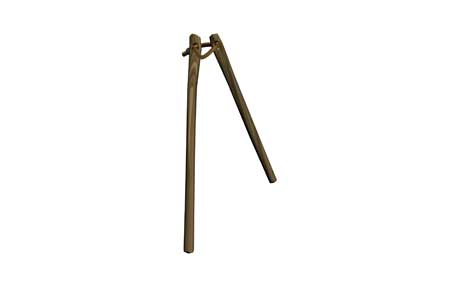
The Scots plough or "wooden plough" (above) epitomizes the primitive state of agriculture in Scotland in the first half of the 18th century. Drawn by a team of horses or oxen (or mixed), the action of the plough did little more than push through the soil creating a shallow furrow and pile up the ploughed land in a series of long, narrow, s-shaped mounds or rigs. The plough was long and heavy with two handles (stilts) and a flat wooden mould board that deflected the soil to the side. The frame was kept together by sturdy wooden pins. With iron so expensive, the only iron parts were the plough share/sock (the pointy part extending in front of the mould board), the coulter (the vertical implement that cut into the soil and began the soil turning process), and the hook/bridle at the front of the yoke.
The plough required a team effort to operate it. Individual farmers would each contribute a horse/ox to the team. The man guiding the plough would need strength just to keep it in the ground. A man or boy would be employed to keep the plough from getting choked with roots and stones. Someone else would drive the team with a whip or sharp stick. It might require several passes through the soil before it was ready for planting.
Here's how the Minister of Kintail described the ploughing operation of the time. The plough's two handles are almost perpendicular; the ploughman therefore stands in an erect position. Four horses all in a breast pull against the beam in thongs of leather cords, generally made of the skins of deer. Behind the ploughman, a man follows with a spade to compress the strong furrows which resisted the side boards. The driver faces the ploughman, holding the reins of the horses collected in a cross stick 3 feet long; in this awkward position, the driver moves backward; and neither example nor precept can convince the people of a better mode of culture. (Stephens)
In Keith, the Minister wrote: A team of 8 or 10 oxen in yokes, sometimes preceded by a couple of horses, is often to be seen creeping along, dragging after them an immense log of a clumsy Scotch plough. (Stephens)
The draught equipment was as primitive as the plough itself. An iron chain (soam) ran from the hook and between the oxen to the front yoke. The yokes were pieces of ash, birch or willow and bent to the proper shape. A pad of dried rushes/straw, or strips of moss was placed underneath the yoke to reduce friction. The traces were made either of dried rushes or strips of wood taken off logs and twisted into a sort of rope. For tethering purposes, home-made hair rope was made from the tails of cattle. Neither the traces not the tethers were capable of withstanding much tension
After ploughing, grain was sown by hand - a slow, labour intensive process since it was difficult to distribute the seed evenly.

After ploughing and sowing in the springtime, the ground was leveled and harrowed. The harrow shown above was a later version with iron picks and it would be drawn by horses or oxen. Earlier harrows were crudely fashioned from wood and it was common practice for lighter harrows to be drawn by women and children.


At harvest, teams of men worked their way across the rigs, cutting crops with a sickle (above left). Women and children would follow to bind and stack the sheaves, one behind each reaper. Harvesting was backbreaking work but had to be completed as quickly as possible when the crop was ready. The sheaves would be threshed in grain sheds where the seeds would be separated from the chaff by beating the heads with a flail (above right). Threshing by hand often meant that grain would lie too long on the damp floor and consequently much of the seed would be spoiled.
After harvest, most Lowland peasants were obliged by the land tenure to take their grain to the water-mill where they paid a heavy multure to have it ground into meal. This servitude was resented and evaded when possible and its imposition made the miller an important but unpopular figure.
There were good years and bad, as always. Sometimes the produce of one harvest was consumed before the new harvest could be gathered, and people then had to scrape a living from wild plants. Each year was a rehearsal for famine, and sometimes the famine came. It was said that every third year brought famine and every sixth year pestilence.
Sources
Steven, Maisie C. Parish Life in Eighteenth-Century Scotland, Scottish Cultural Press.
Various web sites, including
Rural Life in the 18th Century (www.electricscotland.com/history/rural_lifendx.htm)
Scottishmist (www.scottishmist.com)